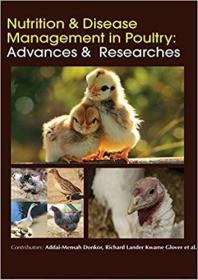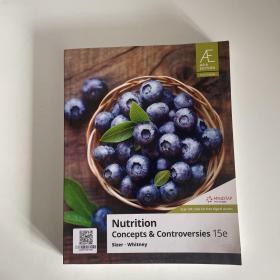
现货Nutrition & Disease Management In Poultry: Advances & Researches[9781682511664]
¥ 4037 九五品
库存2件
作者Addai-Mensah Donkor, Richard Lander Kwame Glover
出版社Intelliz Press LLC
ISBN9781682511664
出版时间2016-01
装帧精装
纸张其他
正文语种英语
上书时间2023-08-08
- 最新上架
商品详情
- 品相描述:九五品
- 商品描述
- Poultry industry being most organized one has the potential to solve the malnutrition problems. However, in recent years poultry industry has crippled many times due to rising cost of feeds and emergence of new or reemerging of existing diseases causing great mortality and morbidity, and heavy economic loss. Feeds and feeding is the most important and major input in poultry production, and the major means of making production system economical. Hence, a suitable feeding package, employing diversified tropical feed resources, exactly matching to the need of the poultry and feeding accordingly is required for exploitation of the inherent production potential of poultry birds that will also surely reduce the wastage of feed, stress to the birds and environmental pollution. The increased incidence of diseases under commercial environment has jeopardized the productivity of poultry. This has become important especially with the establishment of multi-age farms, large holdings, movement of live poultry and their products from one area to other and the spread of travel have created a vitiated environment and helped in vast spread of pathogens. First chapter presents an overview on the estimation of nutritional value of the leaves of moringaoleifera on poultry. Second chapter introduces about poultry nutrition and third chapter explores future trends and developments in poultry nutrition. Diseases of small poultry flocks are described in fourth chapter. Fifth chapter presents the role of early exposure to essential fatty acids through maternal diet and hatching egg and its impact on progeny in meat-type broiler chickens. In sixth chapter, we estimate the volume of antibiotics used for swine and poultry production as these are the two meat sources with the highest levels of production and consumption in China. Seventh chapter presents a unique opportunity to compare the quantification resulted from this emerging, third generation technology to traditional quantification methods currently employed by the poultry industry. The objective of the eighth chapter is to review nutritive value of poultry diets containing sunflower meal supplemented by enzymes obtained by using of enzymes as additives for upgrading the nutritive value of poultry diets containing sunflower meal. Specific diseases of poultry is highlighted in ninth chapter. Tenth chapter provides insight on the use of vaccination for the control of poultry infections in any given country/area/compartment, with particular emphasis on the control of transboundary poultry diseases. Eleventh chapter focuses on aspergillus fumigatus in poultry and twelfth chapter reviews selected published field experiences on the use of EVM in poultry husbandry systems in Africa. The aim of the thirteenth chapter is to understand the impact of the selection criterion, on the characteristics of the gastro-intestinal tract (GIT). Estimation of the genetic parameters should make it possible to establish how selection impacts on the morphology of the gut organs and to offer the opportunity to anticipate any undesirable effects of AMEn selection. Fourteenth chapter indicates the need for continuous assessment of the mycological status of animal feed production, in order to feed animals for optimal performance ensuring food safety. Last chapter focuses on ingredient evaluation and diet formulation.
相关推荐
-
![现货 Nutrition in Obesity & Diabetes[9789351524212]](https://www0.kfzimg.com/sw/kfz-cos/kfzimg/17733071/8850e427ebe57ae3_s.jpg)
现货 Nutrition in Obesity & Diabetes[9789351524212]
九五品上海
¥ 488.00
-

spriggles health&nutrition
九品濮阳市
¥ 12.00
-

Nutrition concepts & controversies
九五品北京
¥ 524.00
-

Feeds & Nutrition Complete
八五品廊坊
¥ 350.00
-

Fertility,Cycles & Nutrition
八五品广州
¥ 120.00
-
![现货William's Nutrition for Health, Fitness & Sport[9781260258974]](https://www0.kfzimg.com/sw/kfz-cos/kfzimg/17733071/4ca4e47336f464e5_s.jpg)
现货William's Nutrition for Health, Fitness & Sport[9781260258974]
九五品上海
¥ 1401.00
-
![现货Nutrition[9781284210958]](https://www0.kfzimg.com/sw/kfz-cos/kfzimg/17733071/445393c41c4a3ddb_s.jpg)
现货Nutrition[9781284210958]
九五品上海
¥ 1730.00
-

Nutrition for Foodservice & CuIinary Professionals
九品上海
¥ 320.00
-

FOOD&NUTRITION CUSTOMS&CULTURE
八五品武汉
¥ 80.00
-
![现货 Samour & King's Pediatric Nutrition in Clinical Care[9781284146394]](https://www0.kfzimg.com/sw/kfz-cos/kfzimg/17733071/df4f0176240c709c_s.jpg)
现货 Samour & King's Pediatric Nutrition in Clinical Care[9781284146394]
九五品上海
¥ 1001.00
— 没有更多了 —
![现货Nutrition & Disease Management In Poultry: Advances & Researches[9781682511664]](https://www0.kfzimg.com/sw/kfz-cos/kfzimg/17733071/1a17d7f91355b5ab_b.jpg)

![现货Materials and Technologies of Modern Production[9783036401683]](https://www0.kfzimg.com/sw/kfz-cos/kfzimg/17733071/5fd2824531e165d7_s.jpg)
![现货Introduction to Container Ship Operations and Onboard Safety[9781032155425]](https://www0.kfzimg.com/sw/kfz-cos/kfzimg/17733071/58b7ff43ef7909ee_s.jpg)
![现货Electrophosphorescent Materials and Devices[9789814877343]](https://www0.kfzimg.com/sw/kfz-cos/kfzimg/17733071/18cc1d77bcb7b488_s.jpg)
![现货Organic Semiconductors for Optoelectronics[9781119146100]](https://www0.kfzimg.com/sw/kfz-cos/kfzimg/17733071/24c85a750c708964_s.jpg)
![现货Advances in Food Rheology and Its Applications[9780081004319]](https://www0.kfzimg.com/sw/kfz-cos/kfzimg/17733071/e0c11603c9119d4d_s.jpg)
![现货Advanced Materials and Sustainable Technologies[9783035727562]](https://www0.kfzimg.com/sw/kfz-cos/kfzimg/17733071/dced675333874c48_s.jpg)
![现货Advanced Materials and Manufacturing Engineering II[9783035712681]](https://www0.kfzimg.com/sw/kfz-cos/kfzimg/17733071/660ccfae75fa8d3e_s.jpg)
![现货Materials in Machinery and Construction[9783035718119]](https://www0.kfzimg.com/sw/kfz-cos/kfzimg/17733071/6f402060775e9daa_s.jpg)
![现货Cereal Grain Quality (Softcover Reprint of the Original 1st 1996)[9789401071772]](https://www0.kfzimg.com/sw/kfz-cos/kfzimg/17733071/f93ca1c96a97403a_s.jpg)
![现货Nutrition & Disease Management In Poultry: Advances & Researches[9781682511664]](/dist/img/error.jpg)
以下为对购买帮助不大的评价